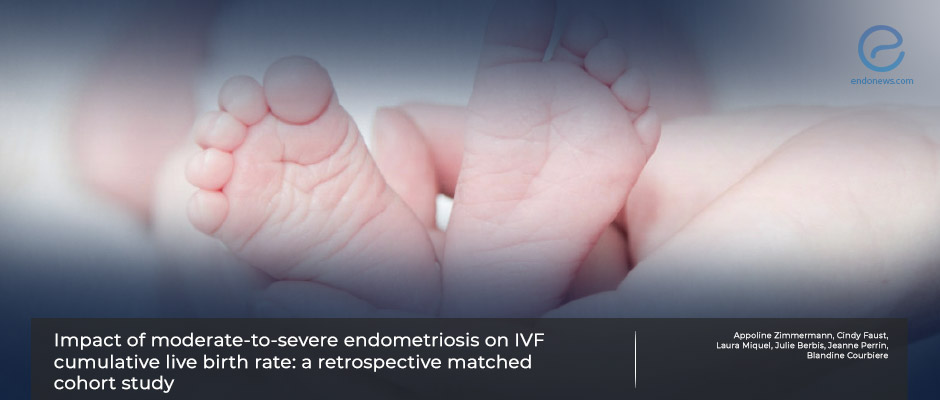Moderate-to-severe Endometriosis and "The Cumulative live birth rate" in IVF Cycles
Aug 18, 2023
Moderate-to-severe endometriosis has no significant impact on cumulative live birth rate in IVF cycles.
Key Points
https://pubmed.ncbi.nlm.nih.gov/37429766/Highlights:
- Although endometriosis causes infertility due to several pathophysiological mechanisms, there is no significant effect on cumulative pregnancy rates when compared to other infertility causes.
Importance:
- The patients with endometriosis who will undergo infertility treatment should be informed about no significant effect of endometriosis on IVF outcomes.
What’s done here?
- This retrospective matched cohort study compares women with and without endometriosis receiving in vitro fertilization (IVF) treatment in terms of pregnancy outcomes.
- The study group consisted of patients with "moderate-to-severe endometriosis" undergoing IVF treatment; women with any infertility factor other than endometriosis comprise the control group.
- Endometriosis was diagnosed with pelvic surgery or magnetic resonance imaging.
- Primary outcome is "cumulative live birth rate per cycle and per woman"; secondary outcomes are the number of oocytes retrieved and number of mature oocytes, fertilization rate, the total number of embryos and usable embryos, implantation rate, clinical pregnancy rate, and miscarriage rate per cycle.
Key results:
- A total of 195 women with endometriosis compared to 390 women in the control group.
- Primary infertility was more common in the endometriosis group.
- Gonadotropin dose for ovarian stimulation was significantly higher in the endometriosis group.
- Although the number of oocytes retrieved was significantly lower in the endometriosis group, there was no significant difference regarding the number of mature oocytes and cumulative live birth rate per cycle and per woman.
- The maturation rate, fertilization rate, total number of embryos, and usable embryos did not differ significantly between the groups.
- Implantation, clinical pregnancy, and miscarriage rates were also similar between the groups.
Strengths and Limitations
- The main strength of the study was the match for the "study" and "control" groups for four potential confounding factors.
- Retrospective and monocentric designs; and the absence of exclusion studies for the presence of endometriosis in the control group are the limitations.
Lay Summary
Infertility is one of the major symptoms in women with endometriosis. The incidence of endometriosis is approximately 10% in reproductive-aged women and up to 40-50% in infertile women. There are multifactorial mechanisms resulting in endometriosis-associated infertility such as anatomic distortion, impaired tubal and sperm motility, and diminished endometrial receptivity.
Dr. Zimmermann et al, from France, published a study titled “Impact of moderate-to-severe endometriosis on IVF cumulative live birth rate: a retrospective matched cohort study” in the journal "Reproductive BioMedicine Online". The authors sought to investigate the effect of moderate-to-severe endometriosis on the cumulative live birth rate.
Participants in the endometriosis and control groups were comparable in terms of baseline characteristics. Although the number of oocytes retrieved was significantly lower in the endometriosis group, no significant difference was detected between the groups regarding the number of mature oocytes and cumulative live birth rate per cycle and per woman. The maturation rate, fertilization rate, total number of embryos, and usable embryos did not differ significantly between the groups. Implantation, clinical pregnancy, and miscarriage rate were also similar between the groups. Subgroup analysis of women with and without cystectomy history did not show a significant difference in terms of clinical pregnancy rate per cycle and per woman. No significant difference was detected for cumulative live birth rate per cycle with subgroup analysis of tobacco users.
“These data are reassuring for the counseling of infertile women with endometriosis before IVF”, the authors added.
Research Source: https://pubmed.ncbi.nlm.nih.gov/37429766/
endometriosis infertility assisted-reproductive technology IVF cumulative live birth rate retrieved oocytes mature oocyte miscarriage rate

